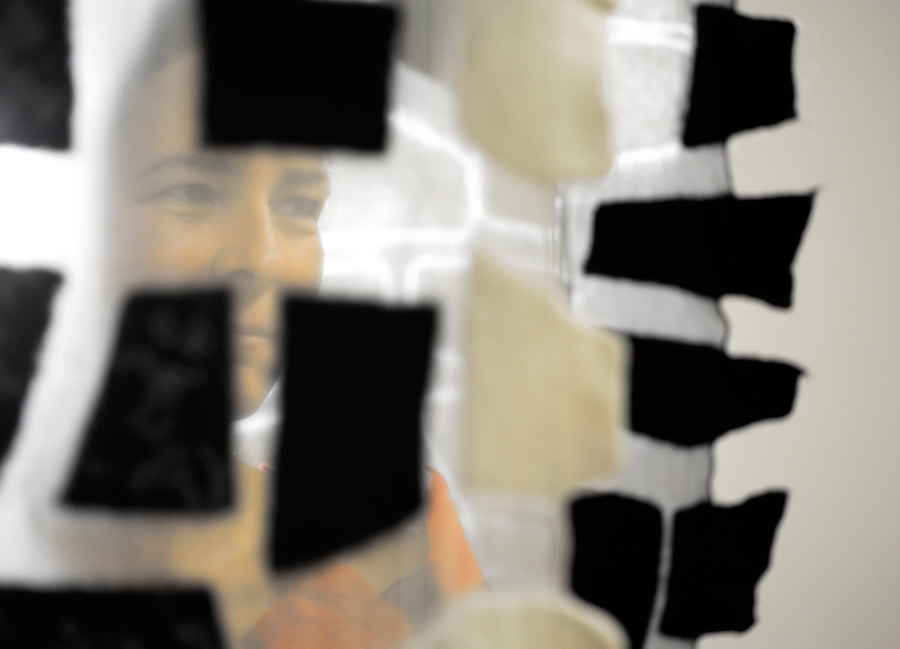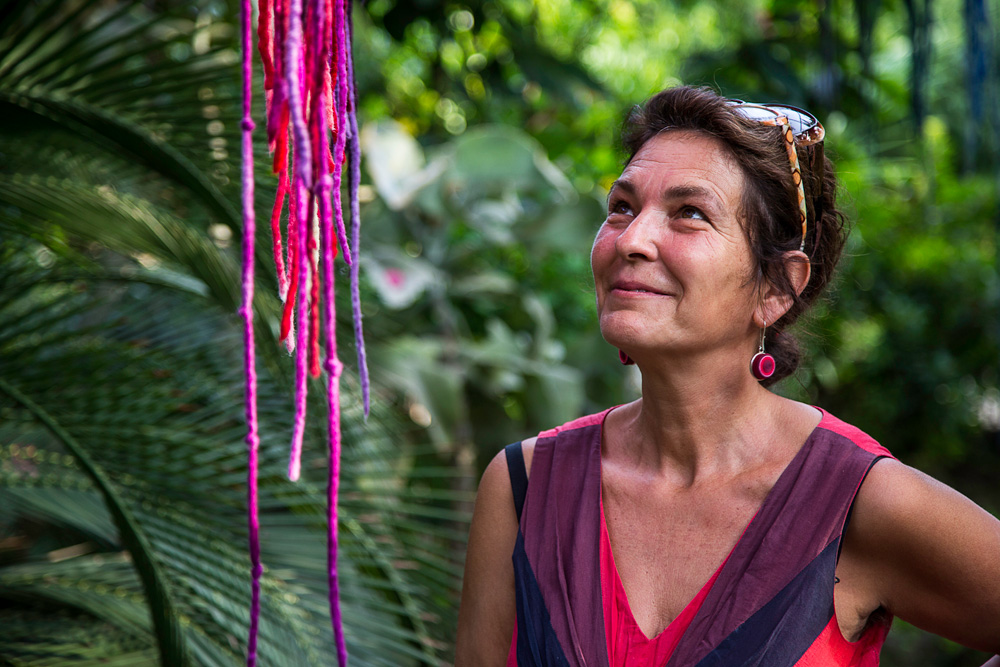It was back in the fifties, after the best season of the Avant-gardes, knitwear in the form of art by designers and creators of fabrics. Since the seventies, the wearability of bodies, things and landscapes has been at work. Knitwear is back to being an artistic medium in all respects and is explored in its expressive possibilities as a way of doing art and together as an approach to the new scenarios of a project, which explores the binomials art and fashion, crafts and fashion, technology and fashion.
Wearable art
Even Bettina Buttgen is a fabric artist and a textile designer: she creates wearable art fabrics. She weaves them, dyes them with colors, she prepares; she paints them and designs them and prepares their possible uses. They can wrap the body like scarves, stoles, shrugs or to knot them, through special “tunnels”, side edges of the stole, folded and closed in such a way as to allow the insertion of the arms or the head, or openings or “eyes”, holes made in the fabric, which allow it to be closed. However, they can also be hung and contemplated as paintings for their beauty and expressive intensity.

The passion and the value not only symbolic but also poetic and sensuous, tactile and visual, of its fabrics give shape to fierce worlds of cloth, to objects full of narratives. Fabrics are chosen and designed as living material.
What shapes the fascination of the Buttgen fabrics are the imaginations and the aesthetic sensibility, which, together with a refined knowledge of the techniques of spinning, carding, color composition, felting, is upstream of its experimentation on fabrics
First of all there is the choice and combination of materials,
all natural, with their tactile and visual valences: first of all silk and pure merino wool and cashmere. But also the delicate, the soft and transparent chiffon, the most resistant crinkle chiffon, with a rippled surface, the elegant and rigid organza, to obtain “worn sculptures”, the innovative Garze, for its unique and noble light, the georgette, due to its fluid and flowing appearance, the noble crepe de Chine, easy to drape. Finally the natural mixtures: silk-wool, silk-bamboo, silk-linen, silk-cotton, silk-cashmere, etc. The tactile properties tissues are fundamental: we need to touch them to understand them, in them the tactile value is in fact primary. Iit is the starting point of a cognitive exploration of the materials conducted through introspection, sensory and emotional, so that the tissue feels the “sound of color” in the material and you can catch the warmth of pure silk or the softness of wool.

The intonation of each piece is given starting from the immersion of its surface in a continuous and relaxed intensity of color and light. The fabrics are in fact colored and painted to declinate them in a wide chromatic spectrum. It is with the painting that Bettina Buttgen narrates her inner life: a painting made of emotions that become lines and colors, light and matter, transparencies and encrustations.
In some fabrics the color intensifies and excites the luminosity to such a point that it comes to materialize the eastern light of the Mediterranean skies, in which the color fades into a transparent, impalpable continuum. It can probe the transparencies of the waters and the depths of the sea. In others it leads to an emphasis on flat two-dimensionality, in contrast to every vectorial direction. The spatial organization of bands or chromatic stripes highlights contiguities and contrasts, and the gesture that established it, in its dynamics and process, in a topologically continuous and not fragmented structure. It makes a sort of musical score constituted by the rhythm of the gesture, a score that has the same generative matrix and its grammar in the different chromatic densities. In others ones, the color is tested with modulations that can enhance saturation and brightness, transparency and material density, its shadows, its depths, its dramatic darkness.
It is a pulsating color, sensuous, carnal, a color-meaning, a color that evokes the wonder in front of every creature of the world, the tree and the leaf, the flower and the stone, the immensity of the sea and that of the skies in their perpetual change, the beating of a bird’s wing, the ecstatic stillness of a gecko. It is in the humble objects that all the most secret and solitary thoughts are ordered. The sun shines in them. For this reason its fabrics give us an auroral and enchanted glance of a world freed from decadence, dissipation, meaningless chronicity, caught in the flow of life. Let’s see, looking at its fabrics, the world of everyday reality and of experience meet with that of things, beings, stories, lives. The experience is anchored in the fabric of life. By wearing them, the body is itself a dreaming subject.
Now she has her atelier in the Negombo thermal park in Ischia, a place that in turn is dreamlike, in which nature, art of the garden and works of great twentieth-century art interact together. It is here that she has stopped and recognized herself, and has her “place”, in which to find and reconnect childhood emotions in Germany, in contact with nature, those of her travels and experiences in Costa Brava, in Poland , in England. It is precisely in this place, that Martin Blume, has created a photo shoot, dedicated to her, of extraordinary intensity. Fixing our gaze, with his magical photographic eye, on the details, he captures us with the play of transparencies, thickenings and material encrustations, and makes us enter the body of threads, textures, warps and those of color, of painting, of the sign. He leads us to stop the gaze on their surface to explore its thickening, pallors and ignitions. And here, when the enchantment captures us, our gaze is caught by a mistake, as if the light had suddenly become too intense, and that’s when our attention is focused on the sign, on the lines, on the brush or it plunges into the depths of matter and color. It is a tactile vision, which leads to dreamlike spaces, suspended in an immobile time and an eternal present in which dream and wake, earth and sky meet, or the waters of dream and reality are mixed.
Photography, a machine that dreams, as Benjamin said, gives us back the profound meaning of the artistic work that consists in re-learning to see the world, through the eye of the artist who dreams the dream of matter. Also the artist and his works and the landscape-garden become one. She at the loom, she as she prepares the colors and the transparency of her face behind the fabrics hanging to dry, she who lives in the park-garden as if it were the womb, while her fabrics blend with the bark of the tree.
Wearable art is not a work of art in the form of a painting, a work that is closed in itself in an absolute space and time. It is art-life, a look that renews, is the return of the eyes, of touch, of sound, of the smell of things. Visionary today no longer concerns the invisible but the visible. It is the ephemeral that creates the world and makes it be, it is the stories, the events, the emotions that make the meaning of life. Life is wandering, memory and remembrance in being here and now in the moment stopped in creation. Weaving life, whose origins sink in the mists of time, has always been a metaphor.. Weaving, weaving, warp, thread, knot are the very way of being-in-the world of thought, of philosophy. The fabric is the word, which creates the world, as the Dogons still say.
So its leaders, each a unique piece, handmade, have a name that refers to the imaginary that put them in place, is the name-title is the color of the work, as Duchamp said. Its signature-logo, a B inside the other, is configured as a spiral that expands, returning to itself to unite the archaic and the contemporary, the archetype continually recreated and the grace of the ephemeral and of flowing over time.
Eleonora Fiorani


